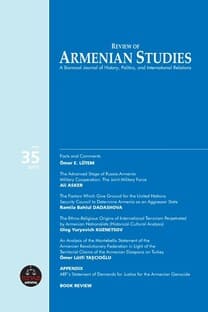A GENERAL APPRAISAL OF THE ARMENIAN ISSUE
Ermeni meselesi, 19. Yüzyılın son çeyreğine denk gelecek şekilde, Osmanlı İmparatorluğunun son günlerinde vahim sonuçlar yaratan pek çok meseleden bir tanesiydi. 1878e gelindiğinde, Osmanlı İmparatorluğunun Balkanlardaki tüm Hristiyan nüfusları bağımsız veya özerk devletler kurmuşlardı. Bu süreçte Müslüman ve/veya Türk nüfusun Balkanlarda sayıca bir hayli fazla olduğu, o coğrafyada yüzyıllardır yaşamış olduğu ve pek çok bölgede çoğunluk oluşturulduğu tamamen göz ardı edilmiştir. Üç büyük milli bağımsızlık hareketi olan Sırp, Yunan ve Bulgar bağımsızlık hareketleri, Müslüman/Türk nüfusun gitmesi ve gerekirse de yok edilmesi konusunda kararlıydı. Ermeni meselesi böyle bir arka plan mevcutken ortaya çıkmıştır. Dayanaksız görüş belirtmenin, ciddi tarih yazımında yeri yoktur. Ancak, Birinci Dünya Savaşı araya girmiş olmasaydı acaba Müslüman-Ermeni barışçıl ortakyaşamanın mümkün olup olmadığı çok cezbedici bir sorudur. Günümüzde Ermeni meselesinde yeni bir döneme giriyoruz. Ermeni diasporasının ve Ermeni propagandasının, Avrupa Parlamentosu, ABD Kongresi ve benzer kurumlardan elde ettikleri ilgiye bakarak kendilerinin başarı elde ettiğini düşünebilirler. Ancak, tam olarak istediklerini elde edecekleri kesin olmaktan çok uzak olasılıktır. Batı akademi dünyasında Ermeni meselesiyle ilgili daha dengeli görüşler yaygınlık kazandıkça, bu görüşler zamanla basına yansıyacak, bu vesileyle de kamuoyunu etkileyecektir. Abartılı görüşlerinin artık kabul görmediğinin farkına varan ve eleştirel incelemelere maruz kalan Ermeni diasporası mensupları (ve eksi Sovyetler Birliğinde yaşamış olanlar), bu meselede tutkuyla kenetlenmiş oldukları konumlarından vazgeçmek durumunda kalacaklardır. Belki bu gelişme olduğunda, sembolik bir uzlaşma yapmak ve akademik bir tartışma gerçekleştirebilmek mümkün hale gelecektir.
(ERMENİ MESELESİNİN GENEL BİR DEĞERLENDİRMESİ)
The Armenian issue was one of the many issues which plagued the Ottoman Empire in its later days, corresponding to the last quarter of the 19th century. By the year 1878, all major Christian peoples of the Ottoman Empire in the Balkans had created their independent or autonomous states. During this process, no attention was paid to the fact that the Muslim and/or Turkish population of the Balkans were a very numerous element, that they had lived there for centuries, that in many areas they constituted majority. All three major national movements the Serbian, Greek and Bulgarian movements were determined that the Muslim/Turkish population should leave, that if need be, that they should be exterminated. It was against this background that the Armenian issue was raised. Speculation is incompatible with serious historiography. However, one cannot resist the temptation of asking whether or not Muslim- Armenian peaceful coexistence might not have been possible, if World War I had not intervened. Today, we are entering a new phase in the Armenian issue. The attention that the Diaspora Armenians and Armenian propaganda has been able to get from the European Parliament, the US Congress and similar bodies, may be seen as a success for them. However, it is far from certain that they will be able to get exactly what they want. As more balanced views of the Armenian issue become prevalent in Western scholarship, these will gradually filter down to the media and thus in turn influence public opinion. Armenians of the Diaspora (and those who had lived in the Soviet Union), seeing that their exaggerated views are no longer accepted, that they are being subjected to critical examination, will have to let go of their passionate positions. Perhaps then, a symbolic reconciliation and a scholarly dialogue will be possible.
___
A Statement Wrongly Attributed to Mustafa Kemâl Atatürk SBF, 1984.A Brief Glance at the Armenian Question Ankara Chamber of Commerce, 1984.
Boudiére, George. Notes sur la Campagne de Syrie-Cilicie, Turcica, tome IX/2-X, 1978.
Congrès National, Documents Relatifs aux Atrocités commises par les Arméniens sur la Population Musulmane Constantinople, 1919.
Gürün, Kâmuran. Le Dossier Armenian Triangle, 1984.
Le Crime de Silence: Le Génocide des Arméniens Paris, Flammarion, 1984. Lewis, Bernard. The Emergence of Modern Turkey Oxford, 1968.
Lowry, Heath W. American Observers in Anatolia ca. 1920: The Bristol Papers, Armenians in the Ottoman Empire and Modern Turkey [1912- 1926], Bosphorus University, Istanbul, 1984.
Mayéwski, Général. Les Massacres dArménie Pétersbourg, Imprimerie Militaire, 1916.
McCarthy, Justin. Muslims and Minorities: The Population of Ottoman Anatolia and the End of the Empire NYU Press, 1983.
Schemsi, Kara. Turcs er Arméniens devant lHistoire Genève, Imprimerie Nationale, 1919.
Shaw, Stanford J. and Ezel K. Shaw. History of the Ottoman Empire and Modern Turkey, vol. II Cambridge, UP, 1977.
Şimşir, Bilal. British Documets on Ottoman Armenians Ankara, TTK. The Genesis of the Armenian Question Ankara, TTK, 1983.
The Andonian Documents Attributed to Talat Pasha are Forgeries! Ankara, SBF, 1984.
The True Nature of the Telegrams Attributed by the Armenians to Talat Pasha, Ankara, TTK, 1983.
Toynbee, A. J. The Western Question in Greece and Turkey Boston, Houghton Mifflin, 1923.
- ISSN: 1303-5304
- Yayın Aralığı: Yılda 2 Sayı
- Başlangıç: 2002
- Yayıncı: Terazi Yayıncılık Basım Dağıtım Danışmanlık Eğitim Organizasyon Matbaacılık Kırtasiye Tic. Ltd. Şti.
Sayıdaki Diğer Makaleler
THE RISE AND FALL OF ASALA AND ARMENIAN REVOLUTIONARY FEDERATION TERRORISM
THE ARMENIAN FORCED RELOCATION: PUTTING AN END TO MISLEADING SIMPLIFICATIONS
ARMENIAN TERROR DURING THE CHANGE IN THE PERCEPTION OF AND REACTION TOWARDS TERRORISM
THE PERFECT ETHNOCIDE: A REVIEW OF BAS KROMHOUT'S DE PERFECTE GENOCIDE'
A CENTURY LATER: TOWARDS TURKISH-ARMENIAN RAPPROCHEMENT?
A GENERAL APPRAISAL OF THE ARMENIAN ISSUE
